A golden legacy with ANDERSEN Genéve
Limited to just 45 pieces to celebrate each year since the founding of the brand, ANDERSEN Genève launches the incredible Communication 45
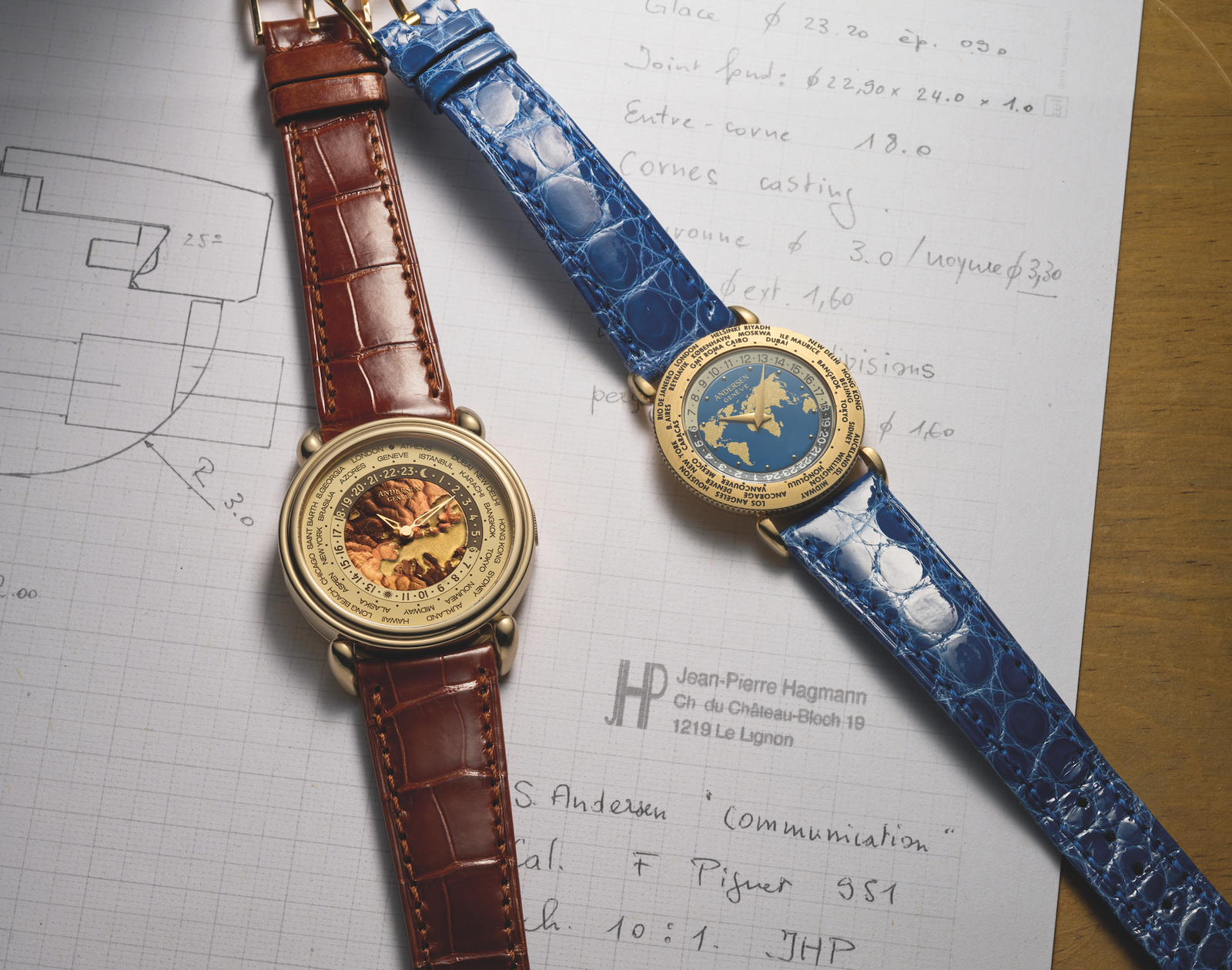
Founded in 1980 by Swiss master watchmaker Svend Andersen, ANDERSEN Genève has become one of the most exclusive watchmakers in the world. A founding member of the Académie Horlogère des Créateurs Indépendants (AHCI), it is one of the few brands to specialise in bespoke haute horlogerie, working one on one with collectors around the world. It is known for its imaginative complications, refined worldtime watches and artistic craftsmanship, which brings a profoundly artisanal approach to each and every creation.
Since 2015, ANDERSEN Genève has been owned and directed by Pierre-Alexandre Aeschlimann, working in close collaboration with Svend Andersen, renowned casemaker Marco Poluzzi, and a small, in-house team of artisan watchmakers.
Operating from its original workshop overlooking the Rhône in the historic Saint Gervais area of Geneva – once home to the city’s famed Les Cabinotiers watchmakers – ANDERSEN Genève creates around 50 watches per year, each one a rare and timeless work of art. In fact, fewer than 1,400 timepieces have been manufactured since 1980. For the last three years, the watchmaker has overseen a second workshop for case- making in La Chaux-de-Fonds.
Now, marking 45 years since the founding of the brand, and 35 years since its very first groundbreaking worldtimer, ANDERSEN Genève has launched an exquisite limited edition worldtime watch. Cased in yellow gold, the Communication 45 is being produced in three series of 15 pieces. The 45 watches represent one for each year of the brand’s existence and are named after founder Svend Andersen’s original worldtimer series from 1990. That original watch is much sought-out today, and cemented ANDERSEN Genève as one of the most influential and enduring names in independent watchmaking.
The new Communication 45 becomes ANDERSEN Genève ’s tenth exclusive worldtimer series since 1990. Refined, technically demanding and ravishing in its detail, it embodies the key values of ANDERSEN Genève’s art: meticulous design and fabrication, the use of exceptional materials and a deep, ongoing commitment to artisanal techniques in both watchmaking and decoration.
Three maps, one global vision
The Communication 45 will be made in three distinct 15-piece series, each with a central dial map depicting one of three regions: Europe, Asia, or the Americas. As with previous ANDERSEN Genève worldtimers, the layout follows the classical format of a 24-hour rotating ring, surrounded by a city disc representing time zones around the world. Local time is displayed centrally using skeletonised, sword-shaped yellow gold hands.
At the heart of the watch is a spectacular, golden-hued map decoration. The centre dial, made from 21ct ‘BlueGold’, is delicately engraved with ANDERSEN Genève’s historic wave-form ‘tapisserie-guilloché’ pattern. Its rich cognac tone is achieved by kiln firing in the ANDERSEN Genève workshop, using the BlueGold process that has become an exclusive hallmark of the brand’s craft. Within this golden sea, the landmass areas are inlaid with yellow gold, via a multi-stage etching and infilling process that was developed specially for this watch.
Designed for citizens of the world
Every element of the Communication 45 has been developed for clarity, balance and refinement. The case, made by hand in ANDERSEN Genève ’s dedicated case workshop in La Chaux-de-Fonds, measures 38mm, with curving, beautifully formed ‘teardrop’ lugs presenting a twist on those used in the Communication series of 1990.
A city-setting crown at 9 o’ clock features a special Communication 45 logo – a globe with the number 45 – while the winding and time-setting crown at 3 o’ clock is capped with a polished ‘A’ logo, an ANDERSEN Genève emblem. Inside, the watch uses a slim, vintage automatic calibre that is completely reworked and deftly hand- finished by the ANDERSEN Genève team, paired with the brand’s in-house, ultra-thin worldtime module.
Back in time
The worldtimer showing 24 time zones simultaneously has been a defining feature of ANDERSEN Genève’s work for 35 years. Now 83 years old, Andersen first encountered the worldtimer system – developed in the 1930s by Louis Cottier, and adopted by Patek Philippe among others – while restoring watches in Lucerne in the 1960s. He then continued to study this feature during a decade in the Grand Complications workshop of Patek Philippe in the 1970s.
In the late 1980s, enchanted by this complication, Andersen developed his own ultra-thin worldtime module at the request of Italian collectors. At just 0.9mm thick, this module became the basis for his first worldtimer, the Communication 24, which was launched in 1990 on a subscription basis. Only twenty-four watches were made, featuring global map dials in blue and gold, complete with gold cases and eye-catching hinged lugs by the late case-making genius, Jean-Pierre Hagmann. Within two weeks of the subscription offer being announced in a German magazine, 18 collectors had paid a deposit to secure one of the watches. Six more would soon follow.
This was followed, also in 1990, by ANDERSEN Genève’s first serially-produced timepiece, known simply as the Communication. It was almost identical to the subscription model, and with a case once again made by JP Hagmann, but this time with tear-drop style lugs. With its classical proportions, city ring bezel and notable lugs, it took clear inspiration from the early Cottier- made worldtimers of Patek Philippe, which had long- since ceased production. It would be another decade before Patek Philippe returned to the worldtime format.
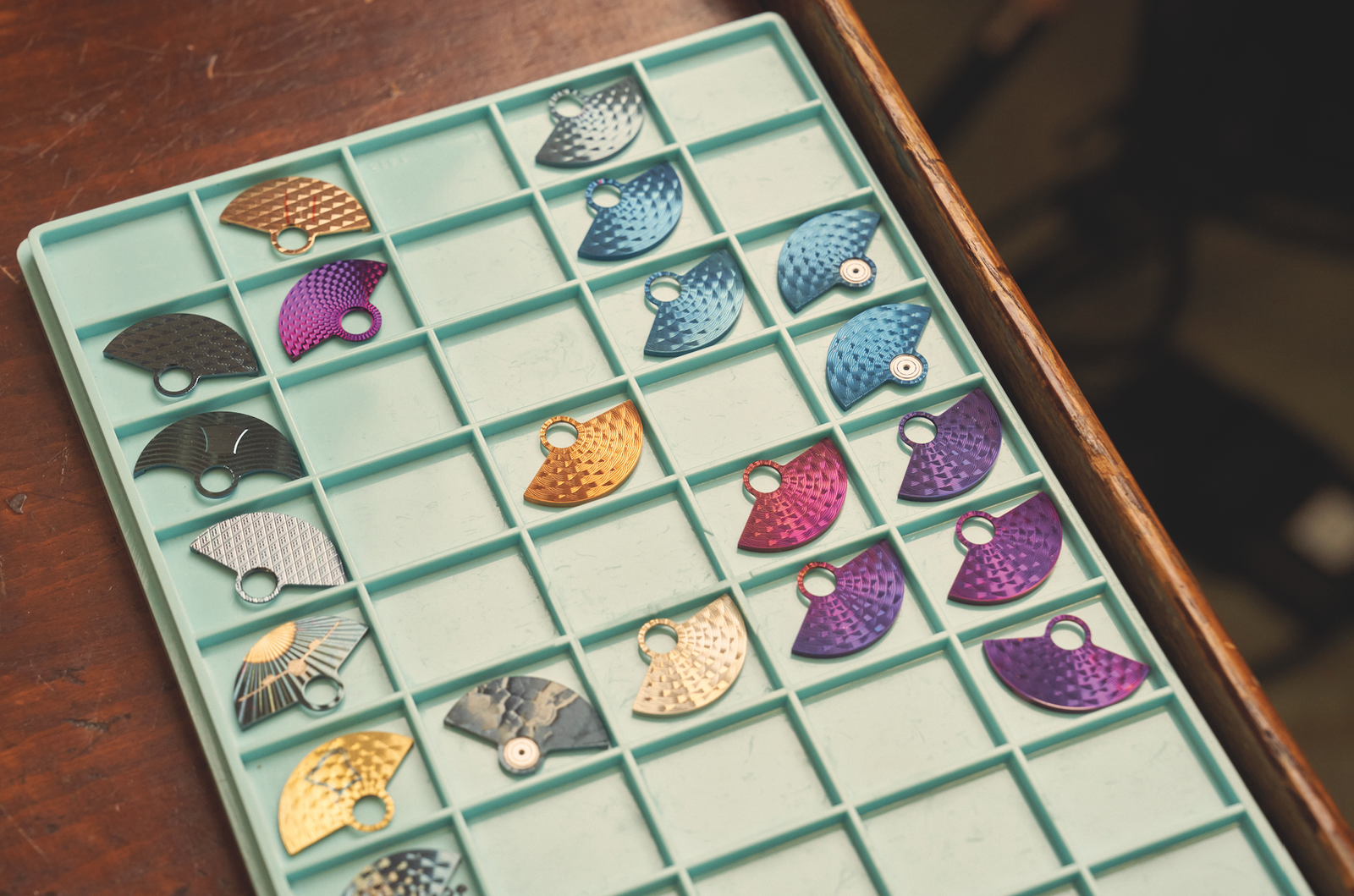
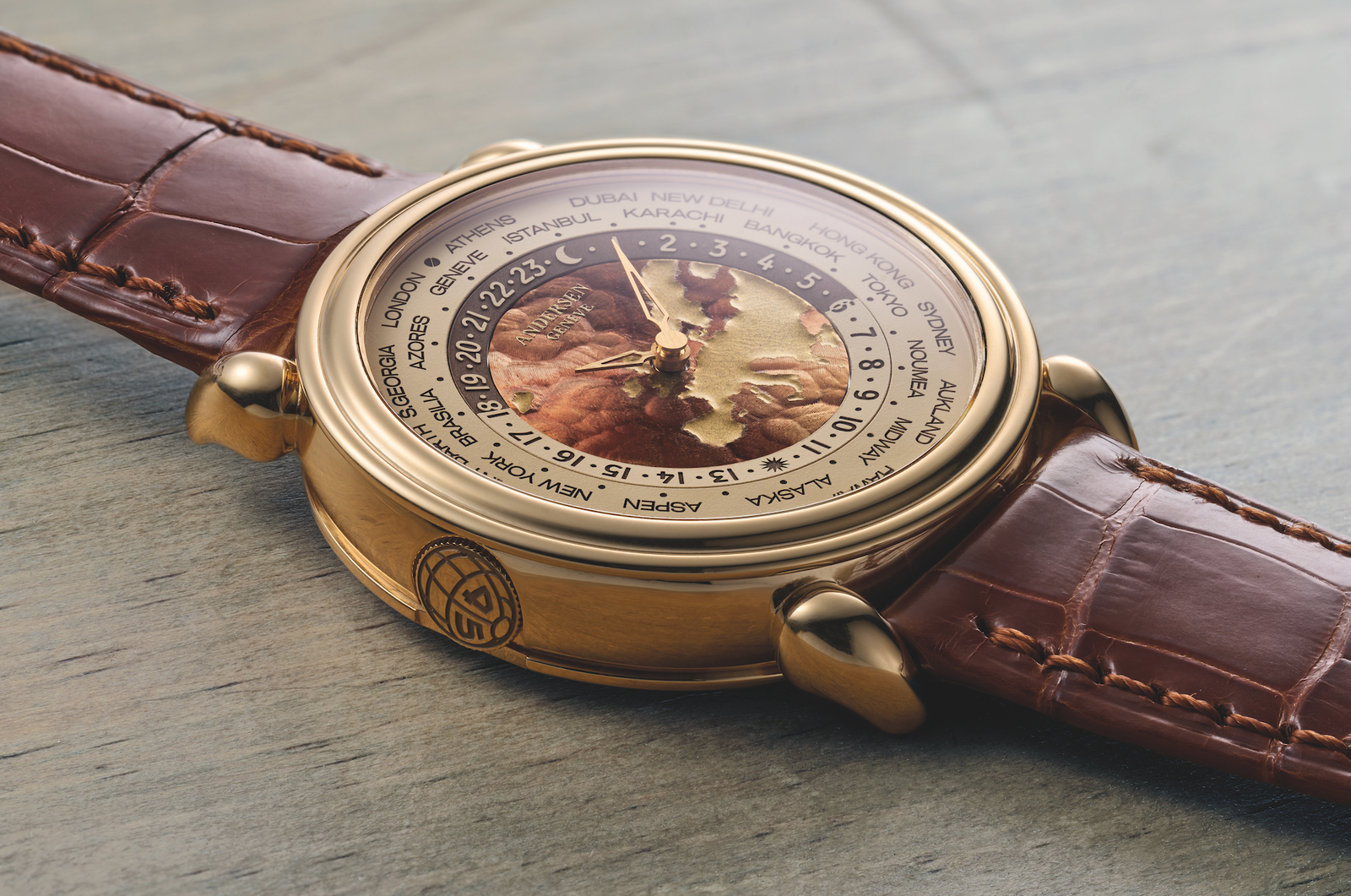
Since then, ANDERSEN Genève has continued to refine and reinterpret the worldtime complication, developing a succession of limited series with classical city-ring layouts and detailed decorative work. These include the Christophorus Columbus (1992), ultra-thin Mundus (1994), the 1884 (2004), the Tempus Terrae (2015), the Heures du Monde in collaboration with Asprey (2022) and the Celestial Voyager enamel series in collaboration with BCHH (from 2021-2024).
Today, and still using Svend’s complication module that has been refined over the years, ANDERSEN Genève is one of the very few independent watchmakers with this kind of knowledge and experience of worldtime design, decoration, and mechanical development. The Communication 45 draws together many of the ideas that have shaped this legacy: elegant construction, precision mechanics, exceptional artistry and highly limited production.
The art of traditional casemaking
Each case is made entirely by hand in La Chaux-de-Fonds by long-time collaborator Marco Poluzzi, without the use of CNC machinery. The Communication 45 features a 38mm case in 3N yellow gold, with a slender three-part construction and a gracefully rounded form, hand polished to a magnificent mirror finish.
The shape of the lugs is one of its most distinctive elements, which combine the teardrop style used by Jean-Pierre Hagmann for the Communication series of 1990 – but with a more sculpted, curvaceous silhouette, viewed in profile, they take on an elegant ‘cornes de vache’ (cow-horn) form. Multiple prototypes were required to perfect the complex, precisely balanced contours and the flawless mirror finish. ANDERSEN Genève was able to draw on Marco Poluzzi’s deep expertise. Poluzzi has been making watch cases by hand for over 50 years, working with many of Swiss watchmaking’s great names.
In 2022, his workshop in La Chaux-de-Fonds, a treasure trove of antique machinery and tooling, was acquired by ANDERSEN Genève, becoming the brand’s second production site. Just as Svend has done with ANDERSEN Genève’s watchmakers in Geneva, Marco is now training a new generation of case-makers (boîtiers) in La Chaux-de-Fonds to carry forward this complex and delicate traditional craft.
21ct BlueGold: Dials of beauty
Dial-making has been a key area of creative focus and investment at ANDERSEN Genève over the past three decades. One of its most recognisable techniques is the use of 21ct BlueGold: gold that is combined with iron elements and heat-treated, developing a coloured oxidation layer on the surface with a resplendent, permanent lustre. While earlier models used blue- purple tones, the Communication 45 introduces a rich cognac shade, achieved through precise control of kiln temperature, time, and atmosphere that has been the subject of considerable experimentation by ANDERSEN Genève’s watchmakers. The BlueGold method was originally demonstrated to Andersen by a Swiss jeweller in the 1990s, who had developed his own, highly specialised process for heat-bluing gold.
It is a technique that, in watchmaking, remains unique to ANDERSEN Genève. With each watch made individually and subject to myriad nuances in timing, chemical make-up, and atmospheric factors, every BlueGold piece becomes a unique in its own right. And each is ultimately governed by the intuition of the watchmaker. The wave-like texture of the BlueGold dial is made by a traditional tapisserie-guilloché process using a ‘tapisserie’ pattern that is over a century old.
A world of detail
The map motif on the dial is achieved using a new procedure developed specifically for this watch. First, the surface layer of the landmass is removed with great precision to a depth of 0.2mm. This void is then infilled with a liquid lacquer of unalloyed gold – similar in principle to traditional shell-gold inlay. Once cured and polished, the result is a smooth, even inlay of pure gold, that lies slightly recessed amid the waveform ‘sea’ that surrounds it. This work was developed through lengthy experimentation and research over several months, in collaboration with three outstanding suppliers in Switzerland.
The city ring of the Communication 45 is circular-brushed and overlaid with cream lacquer. On top of this, a new, bespoke font for the city names was developed to aid perfect legibility. The 24-hour ring features alternating day and night sectors in cream and dark brown.
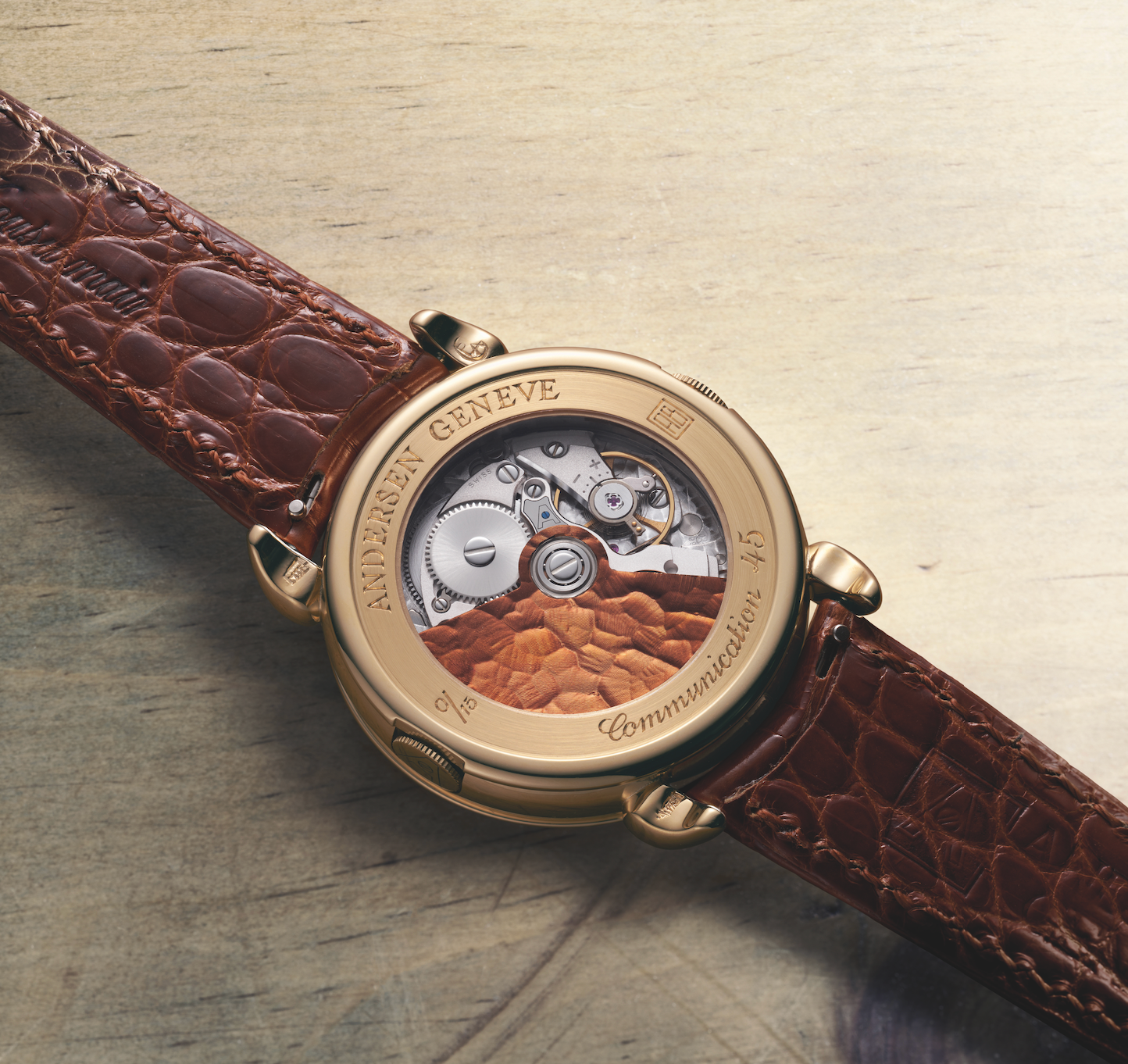
The gold, sword-shaped hands are open-worked and brushed, and the strap is made of dark brown crocodile skin with a yellow gold pin buckle. A domed sapphire crystal with double-sided internal anti-reflective coating completes the construction.
Each case is individually hand-engraved with its edition number and fitted with two crowns, one on either side, in the manner of Louis Cottier’s original worldtime design: one for city selection at 9 o’ clock and one for winding and time-setting at 3 o’ clock. The city-setting crown is engraved with the C45 anniversary logo set within a globe, and the time-setting crown carries the brand’s ‘A’ with screwhead logo. Each watch is individually numbered X/15 according to its regional edition, which is engraved by hand on the back bezel.
Movement from the golden age
The movement inside the Communication 45 is a vintage automatic calibre specially selected by ANDERSEN Genève for its slimness and stability. Such calibres have been used in several of the brand’s worldtimer models including the Celestial Voyager, the Heures du Monde made in collaboration with Asprey, and earlier Tempus Terrae editions.
This is combined with the latest version of ANDERSEN Genève’s in-house worldtime module, based on that originally designed by Svend in the 1980s and continually refined for ultimate precision, efficiency and ease of operation. Each movement is decorated to an incredible level. Bridges and plates are gently frosted rather than striped, giving a matte texture reminiscent of early 20th- century finishing styles, and forming a high contrast with chamfered and polished bevels, all of which is carried out by hand. Screws are mirror polished, and the teeth of the wheels are finished to precise tolerances to enhance both function and appearance.
The rotor, in matching BlueGold ‘Cognac’, carries the same ‘tapisserie’ guilloché as the dial. On the underside of the balance bridge, the brand’s ‘A’ logo is engraved, with its centre a polished and heat-blued screwhead – a quiet detail reserved for those familiar with the brand’s history.
Bespoke commissions
ANDERSEN Genève has also made several special worldtimer series on request, as well as bespoke commissions for unique pieces. These have on occasion seen the worldtimer paired with other complications including minute repeaters, chronographs, perpetual calendars, retrograde displays and alarm functions.
Watchmaking’s global citizen: A conversation with Svend Andersen
Now 83 years old, Svend Andersen has been an influential figure in Swiss watchmaking for over half a century and remains a key part of ANDERSEN Genève’s success. We caught up with him to hear about the brand’s evolution…
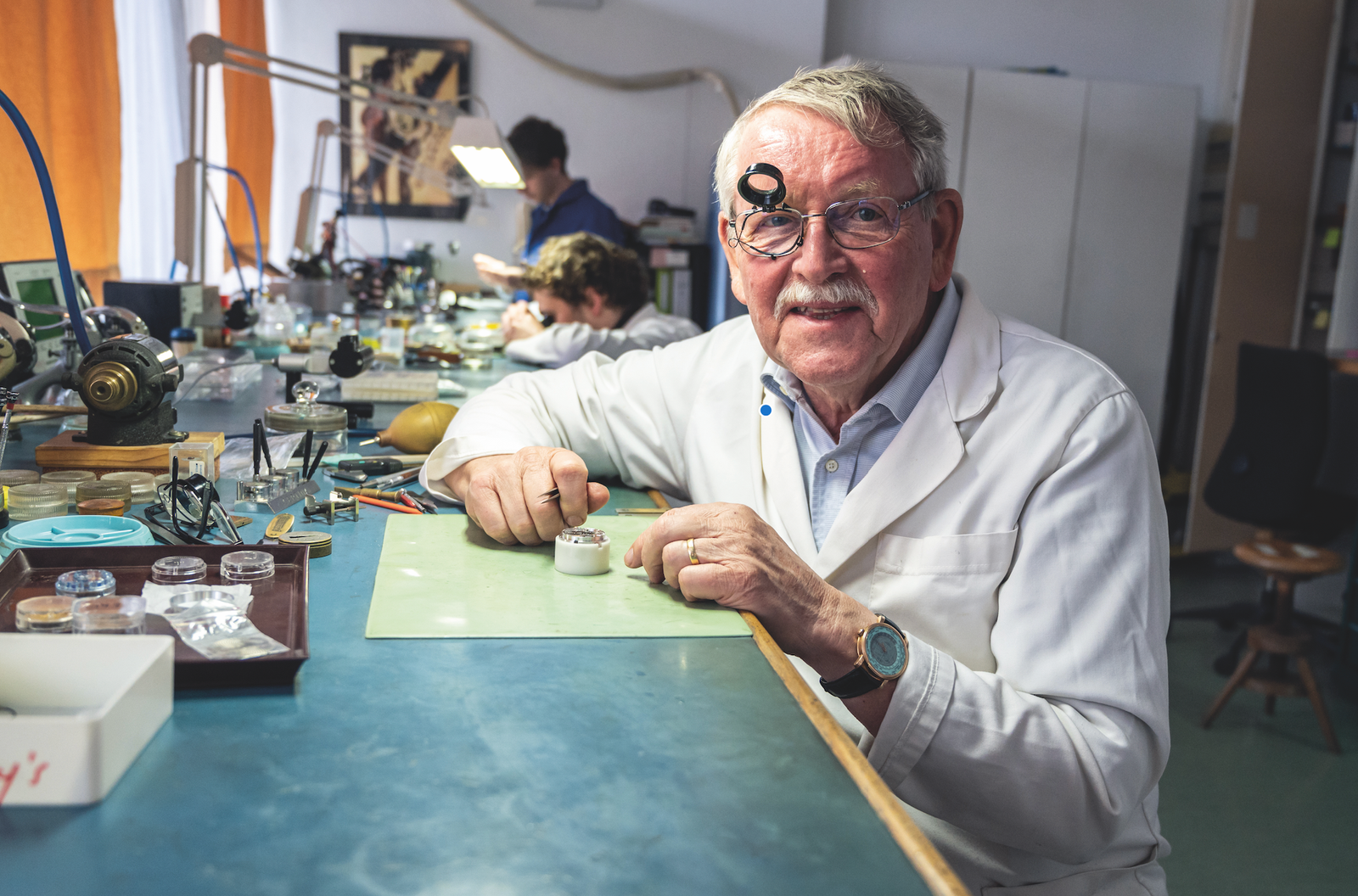
What was your first experience of the worldtime complication?
Svend Andersen: I moved from Denmark to Switzerland in 1963, and because I could speak good English, I got a job at Gübelin [a high-end Swiss watch retailer] in Lucerne. There, I had the chance to repair some of the original worldtime watches, with Louis Cottier’s mechanism. That was my first real encounter with the complication, and it stayed with me.
In the 1970s, you were part of a three- man team in Patek Philippe’s Grand Complications workshop, alongside Roger Dubuis and Max Berney. Did you encounter many worldtimers there?
SA: Absolutely. Louis Cottier had died in 1966 and Patek Philippe stopped making worldtimers after that. But we would repair them. Once, someone came to me with trays of parts from the old Cottier worldtime watches from the 1950s and asked if we can we make watches from these. I looked at them carefully, and said that I think we can save three movements from this. The parts went to another workshop, they made three gold cases, and that was that. But it taught me something important: how special this concept was, how beautiful, and how rare.
You went solo in 1979, and spent the 1980s making pocket-watch cases and then one-off bespoke watches. What led you eventually back to the worldtime?
SA: Some Italian collectors were asking me for something more interesting than just hours, minutes and seconds. I remembered those old Cottier watches, and I thought, why not a worldtime?
So, I began developing my own version. I designed a completely new module, much thinner than what was around at the time. Mine was just 0.9 millimetres, everything included. There weren’t many others around, and those that were used modules that were thicker, like the one from Lemania, and that made the whole watch too bulky. For me, slimness and elegance are very important, especially for a worldtimer.
The Communication started off as a subscription edition of 24 watches. What was the response from collectors like, and how did you get the word out?
SA: When I developed the prototype version, in 1989, I presented it to a German journalist. He published an article, and within two weeks we had 18 subscriptions – out of a planned edition of 24. The other six came soon after. The subscription model meant that people paid 50% in advance, and that gave me the funds to buy gold for the cases and to begin production. We actually made 25 cases – the 25th, which had no lugs at all, I kept. It’s my wife’s watch to this day.
From there, you made the series-produced Communication, as well as a handful of special versions with different dial designs. Why do you think there was such a market for it?
SA: Well of course I was very happy about that. It was very pleasing that so many good people, really committed collectors who loved watches, wanted it. Patek Philippe wasn’t making worldtimers at that time, so in a way, there was a gap in the market. Ebel and a few other brands were doing them, but not really refined. I was going back to what Cottier had invented.
The different dials were made according to the different requests from my retail partners. For example, a cream colour dial with gold map was requested by Yoshi Isogai of the Shellman Boutique in Tokyo. He sold dozens of such Communication with white dials to high end Japanese collectors. There was also a black dial version which was requested by Mr Fagnola of the Fagnola boutique in Turin, for one of his long time Italian clients.
Further information – andersen-geneve.ch
